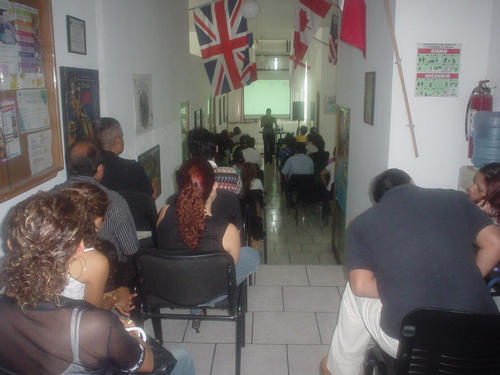|
Quincy-IMCED Teacher Forum "New trends in English Language Eduaction"
Thanks to the cooperation between IMCED, Quincy Institute AC, Empreser and Trinity College London. A 2 day Forum was presented on February 1st and 2nd 2007. Here you will be able to see some of the images from the events and you may even find yourself there.
The guest consultant and presenter of workshops and conferences was Ana Laura Martinez Vazquez, B.A in English Teaching, from Hidalgo University and also consultant for english didactics, self access learning and interactive language education. |
|

The conferences were held at Quincy Institute during the morning and the workshops were held at IMCED during the afternoon.
We had a very successful and enthusiastic participation from several schools around the region, as well as from our students and even some interested parents!
|
2nd. conference at Quincy Institute AC
|
|
|
|
1st. conference
The contents of this page include a summary of the presentation on: LISTENING AND PERFORMANCE OBJECTIVES SPEAKING AND PERFORMANCE OBJECTIVES READING AND PERFORMANCE OBJECTIVES |
Mechanical Skills (perception – internal)
The student perceives differences between his native language and the foreign language. He can discriminate among two or more foreign-language utterances based on the sounds he hears. However, he does not necessarily understand the meaning of the elements among which he makes auditory distinctions. |
|
|
|
Knowledge (recognition – internal)
The student understands the meanings of words and sentences he has been taught. He can carry out familiar commands, match utterances with appropriate pictures, and select an English equivalent of a sentence he hears. All test material appears as it has been taught, and normally only one sentence a time is presented. |
Transfer (reception – internal)
The student understands recombinations of the structure and vocabulary he has been taught. He can answer true- false questions, select appropriate completions to statements or answers to questions, and comprehend passages consisting of several sentences. |
|
|
|
Communication (comprehension – internal)
The student understands instructions and explanations given in the foreign language. The student can understand the general meaning of passages containing unfamiliar vocabulary items or new cognates. He guesses intelligently at what he does not understand and has sufficient skill to fill in elements he may not have heard distinctly. At the highest development of this behavior, the student can understand with ease rapid native speech heard in plays or films and on radio or TV programs. |
Criticism (Analysis – internal)
The student can understand the manner in which the message has been expressed. He can distinguish between various standards of language and perceive geographical regions or social classes represented in speech. In addition, he can comprehend implicit as well as explicit meanings of what he hears. He is conscious of nuances of meaning conveyed by intonation and stress and can describe the mood or tone of the speaker according to his manner of delivery. |
|
|
|
Mechanical skills (reproduction – external)
The student can imitate native models of the foreign language. He can produce native pronunciation, rhythm, stress, etc. He can recite dialogs, poems, sayings, or series of items from memory. He is capable of correctly reading aloud material he has memorized. Although he may comprehend what he is saying, the student can also function at this stage without understanding precisely what each word or phrase means. |
Knowledge (Recall – external)
The student can answer familiar questions according to what he has been taught. He can produce appropriate grammatical forms in familiar contexts. He can read aloud familiar material with accuracy. At this stage, understanding of the material is needed to produce the information requested. |
|
|
|
Transfer (application – external)
The student can vary his responses according to instructions. He applies his knowledge of grammar to the creation of new utterances. The situation in which he does this is highly controlled; he is given precise directions as make. All types of pattern practice, sentence combination, and guided responses fall into this stage behavior. |
Communication (self-expression – external)
The student can express himself intelligibly and can make his ideas and desires known to others. The most guidance he receives is the assignment of a general topic, a particular structure, or several vocabulary words. At the lower end of this stage, the student’s speech may be quite halting bur is nevertheless comprehensible. At the upper end of this stage, the student may be bilingual. Fluency, comprehensibility, ease of expression, and effectiveness of communication are more important evaluation criteria than strict grammatical accuracy. |
|
|
|
Criticism (synthesis – external)
The main concern is no longer whether student can express his ideas, bur rather the manner in which he expresses them. He is capable of using style, and choice of language appropriate to the subject of this discourse and to the people he is addressing. |
|
|